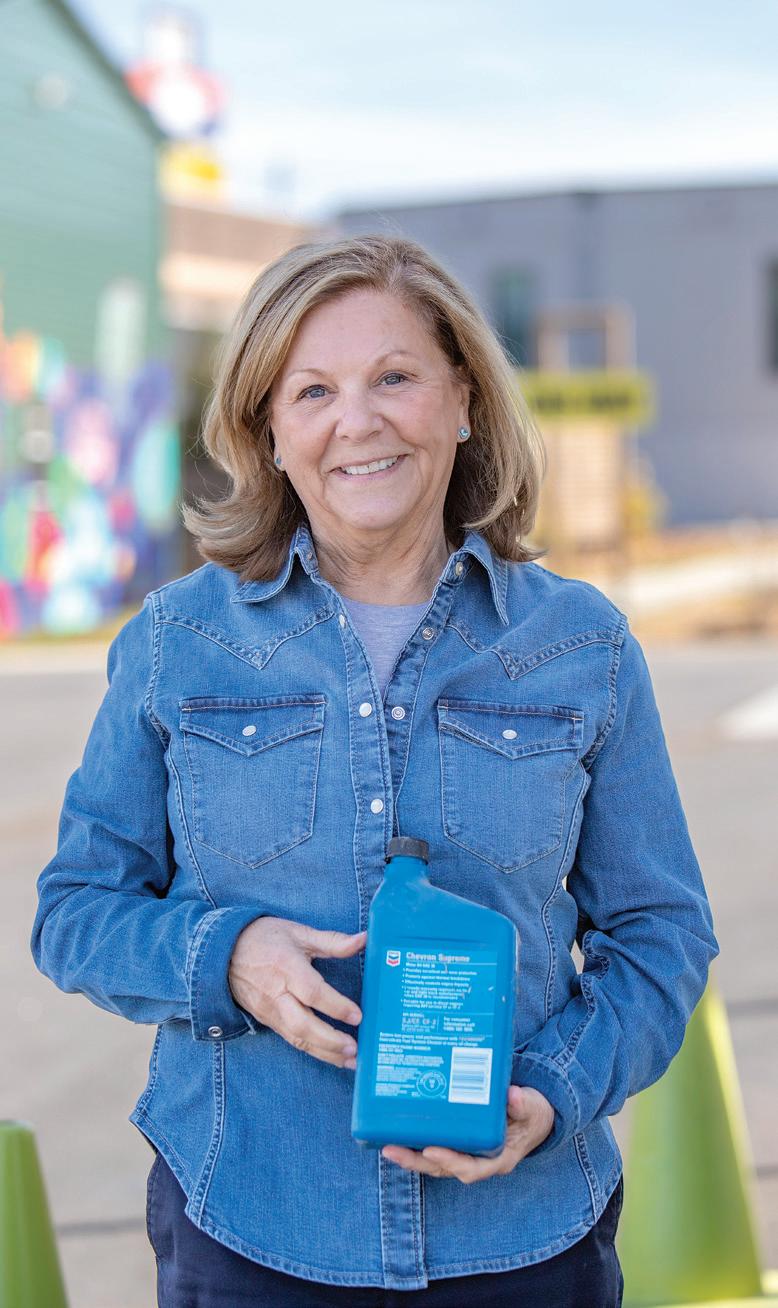Atlanta Intown A

Recycling center marks milestone with two locations and a third on the way P8



Recycling center marks milestone with two locations and a third on the way P8

The demand for homes in Morningside is at an all-time high, while available properties for sale are at a historic low. Now more than ever, it’s crucial to have an experienced real estate advisor who not only understands our unique neighborhood and what makes it special but also has expertise in the luxury market.
A carefully crafted plan for selling your home is essential, one that covers every detail—from preparing your property for market to explaining the various steps involved in a successful sale. After all, selling your home, your most significant investment, requires a strategic approach.
With 25 years of outstanding success as a listing agent specializing in Morningside, I’ve had the privilege of advising a diverse range of clients, from sports team captains and top executives to music and movie moguls, as well as longtime Morningside residents. My goal is always to tap into every ounce of value your home holds and maximize your results.













Beth McKibben
Cathy
Sammie Purcell
Katie Burkholder, Bob Pepalis, Logan C. Ritchie, Sarra Sedghi
Sally Bethea, Isadora Pennington


Circulation
Each month, 27,000 copies of Atlanta Intown are mailed to homes and distributed to businesses in and around ZIP codes 30306, 30307, 30308, 30309, 30324 and 30329. For delivery information, delivery@roughdraftatlanta.com
To subscribe to home delivery, ($125 / year) email delivery@roughdraftatlanta.com


The City of Atlanta’s contentious relationship with MARTA was on full display in March when Mayor Andre Dickens appeared before the transit agency’s board to dispute audit findings and walk back his support for extending the Downtown streetcar along the Atlanta Beltline Eastside Trail.










Now, Dickens wants to see the streetcar head south to the future Murphy Crossing redevelopment and west to Atlanta University Center. He’s also still bullish on MARTA building four new infill stations along the existing lines. It appears the new strategy from the Dickens administration is to get some kind of rail to the Beltline instead of actually on the 22-mile loop.
With no timeline in place, the can gets kicked down the road again – well beyond a potential second term for Dickens. And let me tell you, the can is dented, rusty, and nearly unrecognizable.
MARTA has already poured millions of dollars into plans to extend the streetcar from Downtown to Ponce City Market. I know it sounds insane to many, but that big grassy area off to the side of the Eastside Trail was left there for future rail. It was part of Beltline visionary Ryan Gravel’s original plan back in 1999.
Since there has been zero planning or study on running rail to Murphy Crossing or the Westside, we’re looking at years
– and millions more of our tax dollars –before this is even feasible. Meanwhile, the Eastside Trail line could have likely been finished before the end of Dickens’ hypothetical second term. It’s a crazy waste of time and dollars.
I lived directly on the Eastside Trail for 16 years and watched it transform from an abandoned railroad line to the thriving urban trail it is today. Since my move to Midtown a few years ago, I’m still only a mile from the trail. I make no apologies for wanting the rail portion of the project we were promised more than two decades ago to proceed.
I’ve said it before and I’ll say it again: One of the biggest mistakes Atlanta ever made was tearing out the old streetcar system in favor of the automobile. There are businesses and educational institutions that want to tear down historic buildings in favor of parking lots. Atlanta still can’t let go of its obsession with driving, and Dickens’ hemming and hawing over rail on the Beltline perpetuates the idea that we aren’t serious about solving our traffic problems.
Look, I’m all for adding more MARTA stations, but we also need new rail lines that will take residents and visitors to more places they want to go. Beltline rail would connect 45 neighborhoods around the city. One more time for those in back: 45. The new “plan” floated by the city is a disconnected series of driverless pods, light rail, and bus rapid transit on and along the Beltline. The cost and timeline are unknown. It’s a messy, unworkable idea that won’t be Dickens’ problem, but will be part of his legacy.












By Collin Kelley
The upgrade to Atlanta’s failing water infrastructure will cost an estimated $2 billion and take 20 years to complete, according to Mayor Andre Dickens.
Dickens announced the estimated cost and timeline on March 18 at a press conference at Shirley Franklin Park, the former Westside Park that holds Atlanta’s backup reservoir.
The mayor said the U.S. Army Corp of Engineers and the Atlanta Water Advisory Group, impaneled after last summer’s water main breaks crippled parts of the city, are working to make recommendations for the upgrades and improvements.
Current Atlanta Watershed Commissioner Al Wiggins Jr. said the city had already invested in new leak detection software and artificial intelligence programs to monitor the 4,000 miles of pipes that run under Atlanta. He said leak detection devices have also been placed in critical locations like hospitals.
Wiggins said the city has also invested $15 million in upgrades to the R.M. Clayton Water Reclamation Center, which is Atlanta’s largest wastewater treatment facility. Environmental watchdog group Chattahoochee Riverkeeper filed a federal lawsuit against the city over ongoing pollution discharge into the river last September.
Atlanta Chief Strategy Officer Peter Aman said the upgrade to the city’s century-old water pipes will be a “large and complex” issue that will span multiple mayors and iterations of the city council before it is complete.
Dickens described Atlanta’s water woes as a “100-year-old issue in the making” before introducing the incoming Atlanta Watershed Commissioner, James “Gregory” Eyerly, who will begin work on April 1. Wiggins has been promoted to senior advisor to the city’s chief operating officers.





Eyerly most recently worked as the Director for the City of Houston’s Department of Water Division. He began his career more than 30 years ago and is well-versed in dealing with state and federal agencies, where the city hopes to secure funding for the project.
Dickens wouldn’t rule out a future rate increase for city water customers but said it was too early to tell as the project parameters were still under discussion.

Eyerly said his long-term vision for the city is “water security with operational excellence with first-class infrastructure.”
“I believe we can achieve all of this through increased transparency and trust,” Eyerly said. “We need to talk about what our issues are.”

‘reprioritizes’
By Collin Kelley
Mayor Andre Dickens appeared at the MARTA Board of Directors meeting on March 13 to reject the findings of a new spending audit and reprioritize extending the Downtown streetcar to the Atlanta Beltline.
The new audit of the More MARTA capital fund program claims the transit agency only owes $865,630 rather than the $70 million figure in last year’s audit from the City of Atlanta.
The city claimed last year that MARTA overshot its operational budget by $70 million for expansion projects funded by a city sales tax. The city hired accounting firm Mauldin & Jenkins to conduct the audit.
However, the new assessment by KPMG said MARTA only owes the More MARTA capital fund $865,630 as of June 30, 2022.
Dickens rejected the findings of the KPMG report while admitting the city had only had the document in hand for 36 hours.
“What KPMG did was not an audit. It was a review of the allocation process for More MARTA,” Dickens said. “I know it, KPMG knows it, and so does this administration of MARTA. So I reject the financial conclusion in this report and stand by the findings of the original audit.”
Dickens called the “so-called audit” a “slap in the face” to Atlanta taxpayers who are providing the funding through the sales tax. He urged the board to work with the city and stakeholders to resolve differences and move forward.
Dickens also denied that the city was holding up permits to begin work on the renovations of the Five Points Station. He said the permitting process was not connected to the audit issue.
“We are not holding up permits for the Five Points Station project,” Dickens said. “We want this project to move forward and start ASAP. Anyone who has told you that we are holding up any permits is simply lying to you.”
The city’s Chief Operating Officer, LaChandra Burks, said the demolition permit to remove the canopy at the Five Points Station, which is the first phase of the renovation plan, was issued on March 13.
Dickens also walked back his support for beginning the extension of the Downtown streetcar line to the Eastside Trail and said a southside extension to the planned Murphy Crossing development was more feasible.
The city issued a press release clarifying its intentions for the streetcar extension, which still includes extending the streetcar to the Eastside Trail as part of “Phase 1 of streetcar/light rail construction” as well as an extension west to the AUC or Georgia Tech.
“I’m a fan of light rail, I always have been, it’s been my interest in it since the very beginning,” Dickens said. “The hope is that one day rail can be put on the Beltline. The short-term look at this is: How do we start this process?”
Dickens said he believed the future of the Beltline is going to be multimodal with both light rail and other forms of transit.







By Collin Kelley
The Center for Hard to Recycle Materials – or CHaRM – is marking its 10th anniversary with a series of events at its DeKalb location and news of a third location coming to the Westside of Atlanta.
Managed by local environmental nonprofit Live Thrive, CHaRM was the brainchild of executive director Peggy Whitlow Ratcliffe after her parents passed away and she was tasked with cleaning out their home.
“My parents were gardeners and they had old pesticides and herbicides and there was nowhere to recycle them,” Ratcliffe recalled. “So, CHaRM started as a personal need and became a passion.”
The original Grant Park location opened a decade ago and collected more than six million pounds of hard-torecycle materials, including plastics, paint, chemicals, cardboard, appliances, and more.
Nearly one year ago, the DeKalb location opened on Columbia Drive in Decatur and has already proven to be


popular with residents. Ratcliffe said plastics have been the most collected item, with more than 107,000 pounds collected since the center opened last June.
“Decatur folks are so dedicated to their recycling,” Ratcliffe said. “We get more plastic than anything else. Styrofoam, grocery bags, plastic straws, and utensils all get separated and recycled here.”

CHaRM DeKalb is also an educational destination with more than 400 third to fifth-graders, as well as summer camp kids, visiting so far to learn more about recycling.
There was concern that the Decatur location would drain away recyclers from Grant Park, but Ratcliffe said that never materialized with more than 5,000 residents bringing items in 2024.
Buckhead residents might remember that CHaRM was hosting a regular popup partially funded by the Atlanta City Council. The pop-up fell victim to the COVID-19 pandemic lockdown.
However, Ratcliffe said Live Thrive is working in partnership with the City of Atlanta to open a third location of CHaRM near the redevelopment of the Bowen Homes site on the Westside. She said funding was obtained before the Trump Administration began freezing and slashing grants.
Ratcliffe acknowledged that the next four years would be challenging, but said Live Thrive would be counting on recycling fees from residents, local grants and corporate sponsorships to keep the program alive.
As part of the 10th-anniversary celebration and to mark Earth Day, CHaRm DeKalb is hosting a series of events, including a free kids' day on April 26 at 9 a.m. featuring interactive and educational activities.
A plastic collection contest is also set to take place at local schools in the three weeks leading up to Earth Day on April 22. Live Thrive will pick up all collected plastic from each school and take it to a CHaRM location for weighing and proper recycling. The class or school with the highest weight of plastic collected will receive a cash prize toward its STE(A)M and environmental education.
Student artists in grades K-8 are also

encouraged to enter the annual Earth Day t-shirt contest. More details can be found at livethrive.org/t-shirt-contest. And the CHaRM Corporate Challenge will mark its fifth year, which encourages local corporations and their employees to recycle. Over the last four years, the challenge has collected 480,000 pounds of material, Ratcliffe said.
Companies can register on the Live Thrive website, and throughout the challenge, each drop-off will be weighed and recorded, so the total number of pounds diverted can be determined. Current 2025 Corporate Challenge participants include Chick-fil-A, CocaCola Bottling Company United Inc., Cox Enterprises Inc., Delta Air Lines, EY, Interface, Monarch Private Capital, Novelis, Oldcastle Infrastructure, Printpack, and The Home Depot Foundation.
For more information on any of the events and to find out more about recyclables accepted at the CHaRM facilities, visit livethrive.org.





























































By Beth McKibben
Bryan Rackley stood at the Kimball House host stand looking out into a dining room filled with second graders from his son’s elementary school. They were at the Decatur restaurant to learn about oysters, particularly the work he and his Kimball House partners do with Shiny Dimes, the oyster company and aquafarm they own along the Florida panhandle.
Questions from the two classes in attendance that day ranged from asking how oysters grow and what they eat to Rackley’s favorite chore at the farm. He found the kids’ excitement and curiosity about oysters – and why people like eating the knotty-shelled bivalves – invigorating.
“Marine sciences are important, and I could see their little wheels turning as I answered questions. It was cool to see these kids engaged,” Rackley said, who brought

out props from the oyster room at Kimball House to help explain his answers.
At full maturity, one adult oyster can filter up to 1.3 gallons of seawater every hour–or nearly 30 gallons a day–removing algae, undissolved fine particles, and organic and inorganic pollutants from the water. Rackley grabbed a five-gallon bucket to demonstrate to the children the enormous amount of water one oyster can filter over 24 hours.
Rackley’s own curiosity about oysters led to Shiny Dimes. After multiple field trips to various farms over the years on behalf of Kimball House and reading as much as possible about oysters, oyster habitats, and how much oysters benefit the surrounding environment, founding Shiny Dimes felt like the next natural step.
Rackley wanted better tag dates for the oysters the restaurant served. Tag dates list the original harvest date and location. Oysters have a shelf life of up to three weeks, so the closer to harvest date, the better an oyster tastes. With a year-round growing season in Florida, Shiny Dimes oysters can be harvested as soon as they reach maturity.
I didn't want Shiny Dimes to compete with other farmers, I just wanted to be part of the story,” Rackley said. For now, Kimball House remains Shiny Dimes' biggest customer, with some of its oysters sold for distribution through Evans Meat & Seafood.
Shiny Dimes can grow as many as 100,000 Virginica or Atlantic oysters a year from seed per acre. The company currently leases two one-and-a-half-acre plots in Spring Creek, FL, on Oyster Bay, along with an unused plot 32 miles south in Alligator Point.
On average, Kimball House customers consume between 600,000 to 700,000 oysters each year, many of which now come from Shiny Dimes. The farm’s oysters take six to eight months to reach maturity, grown in black mesh bags floating on top of the water meant to speed growth and produce higher quality oysters for eating on the half shell.
But a lot can happen during those precious growing months on an intensive aquafarm like Shiny Dimes. Last year, the farm lost 70,000 maturing oysters to Hurricane Helene and was forced to purchase another 40,000 oyster seeds from a hatchery near Tampa. It was a big hit for the fledgling oyster operation, founded by Rackley and his Kimball House partners Miles Macquarrie, Jesse Smith, and Matt Christison in 2019.
The foursome only harvested their first batch of Shiny Dimes oysters in 2022.

“We try to grow on the farm the same way we grow at the restaurant. Big leaps are tricky. There's a big margin for error. So we always try to stage our growth to be more manageable. You have to work slow and smart,” said Rackley. “Growing is mostly management and monitoring and timing it all.”
Starting in mid-April, when the weather and water are warmer, oysters grow incredibly fast. Rackley said they stagger the growth cycle to ensure the entire farm
isn’t market-ready at the same time or end up with oysters in August that are huge and covered in barnacles.
Harvest time sees Rackley and his partners pulling heavy bags of oysters from the water onto their small shallowbottomed boat. Oysters are rinsed and inspected by hand to ensure shells are tightly closed, not dried out, or producing a strong odor, indicating spoilage. Empty bags are then thoroughly rinsed, reseeded, tagged, and put back into the water. It’s hard work, but skipping steps can be costly.
“Every time we harvest it feels like this incredible feat. There’s a pretty steep learning curve, especially for a bunch of city boys,” Rackley said. “Thankfully we have oyster farmers next to us who can check on things and have been so helpful and great resources. I learn new things every time I’m there.”
Rackley asked the kids attending his oyster talk if they knew anything about keystone species. Hands quickly shot up, leading him to explain the role oysters play as a marine keystone species.
As a keystone species, oysters disproportionately impact the environment around them. Removing oysters from that environment upsets the delicate ecosystem these bivalves help maintain, including building up natural reefs to curb beach erosion and filtering thousands of gallons of seawater daily.
During the filtration process, oysters feed off phytoplankton, making their entire lifecycle self-sustainable and farming low-maintenance. By consuming phytoplankton, oysters keep the ecosystem in check, allowing more sunlight to reach microscopic plants and organisms living in the water. These microscopic plants and organisms attract other marine life to the area.
But the good oysters do for the marine environment doesn’t end when they leave the warm waters of the Florida Gulf Coast. Kimball House collects hundreds of thousands of discarded oyster shells yearly in a special receptacle beside the restaurant. Once full, shells are hauled away and dumped back into the ocean as part of the continual reef restoration work along the Georgia coast by the Department of Natural Resources.
“What drove me to start Shiny Dimes was getting my hands dirty and learning something new,” Rackley said. “I have so much more respect for nature because of Shiny Dimes and appreciate the physical and economic investment of oyster farmers.”
Talking with a group of inquisitive second graders about oysters, felt like a fullcircle moment for Rackley.
“It’s very seldom that I get to go to Shiny Dimes with my son but he’s experienced Oyster Bay and the hard work,” Rackley said. “He knows it’s important and has heard me talk about the types of different species in these coastal areas and what oysters and other animals do out there. I would farm oysters full-time if given the opportunity.”



Kettles of broad-winged hawks circled high in the sky on updrafts of warm air, as I lay on the grass near the Blue Ridge Parkway on a sunny fall day. Their swirling, southward movement (compared to boiling cauldrons, or kettles) was calming and mesmerizing: a memory I’ll never forget.
ABOVE THE WATER LINE

Migrating thousands of miles along the spine of the Appalachian mountains, these raptors rely on large wooded areas to rest at night. America’s “best idea”—our national park system—helps them on their way by providing protected forests. More than 800,000 acres of Appalachian land has been preserved in the Shenandoah, Blue Ridge Parkway, and Great Smoky Mountains National Parks alone.
Writer Wallace Stegner described our national parks as “absolutely American, absolutely democratic; they reflect us at our best rather than our worst.” According to filmmaker Ken Burns: “We were the first nation in the history of mankind to say that the most special places should be set aside not for royalty, not for the rich, not for the well-connected, but for everyone and for all time.”
Some of the most unforgettable experiences in my life have taken place with family and friends in our national parks: beautiful and fascinating places where it’s possible to build strength and resilience in body and mind and learn to appreciate the non-human species on our planet.
Annually, the federal government invests $3.6 billion in our national parks, serves more than 330 million people annually, and generates an astonishing $55 billion in economic output: a return on investment of 1500%! Despite being understaffed and saddled with deferred maintenance projects totaling more than $20 billion, the National Park Service (NPS) has managed to deliver outstanding recreational opportunities, while safeguarding the natural treasures that belong to every American.
Today, however, it’s a different story. Chaos and uncertainty reign throughout the park system and among the people it serves. Immediately after taking office, the environmentally hostile Trump regime began an attack on our national parks— and on dozens of other Congressionally approved federal programs.
Within weeks, nine percent of NPS staff were lost to mass, indiscriminate firings and resignations, on top of a hiring freeze on vacancies. While positions have been reinstated by court mandate, it’s uncertain






whether former employees will return, and more layoffs are expected during an anticipated reduction in force. Additionally, credit cards have been frozen, preventing park staff from buying needed supplies and paying contractors and utility bills. Contracts over $50,000 are being delayed, undermining maintenance work. Thirtytwo NPS leases are on hold, threatening the closing of visitor centers, park headquarters, centers for dispatch and public safety, and maintenance facilities.
Why is this happening? Why is this beloved federal program—which significantly boosts local economies and costs less than one-fifteenth of one percent of the federal budget—under such a vicious assault?
Does the Trump regime intend to privatize our national parks, selling them to the highest bidder for private gain through extraction and exploitation? Is this some sort of revenge scheme on the part of officials who abhor regulations, even those that protect natural heritage areas? Or, are they dismantling an institution that might harbor opponents (scientists, environmentalists, and nature lovers): a classic move in the authoritarian playbook? The answer may be all of the above.
Three hours north of Atlanta lies the most visited national park in the system— Great Smoky Mountains, a half-millionacre hotspot of beauty and biodiversity. I’ve seen synchronous fireflies produce their light show, blinking in unison in a pitchblack forest. From Cliff Tops near Mt. LeConte Lodge—the highest guest lodge in the eastern U.S.—I’ve watched the sun set in rainbow sherbet colors over hazy blue mountains.
I’ve admired a mother bear and two cubs playing along a mountain stream. I’ve sought and found pink lady’s slippers, Dutchman’s breeches, painted trilliums, spring beauties, and other wildflowers. And, I’ve climbed to Ramsey Cascades, the tallest waterfall in the park with a 100’ vertical drop. All powerful memories.
Twelve million people visit the Smokies every year. Already underfunded and understaffed, the park now has a dozen fewer employees, according to reports. Even if they are reinstated and willing to return, they face uncertainty and turmoil with more planned staff reductions and a clear message from above that parks aren’t a priority.
The Chattahoochee River National Recreation Area is reported to have lost four staff members. With frozen vacancies and less than two dozen people to manage a 48mile linear park before the cuts, according to one source, visitor safety could be at risk this summer. Georgia has ten additional units of the national park system that are also threatened, despite their positive impact on local economies.
Shaken and Scared
I’ve spoken with employees who are visibly shaken and scared, not knowing if an email will end the careers they love. They are frightened to talk about any topic related to their parks because the Trump regime has told them not to make any public statements without prior approval from headquarters. Most of these individuals took jobs with the NPS because of their passion to protect the environment and help people safely enjoy spectacular landscapes; they also save lives and make children smile.
Without sufficient staff, you may find the following on your next visit to a national park: closed or poorly maintained bathrooms, reduced hours at—or closed— visitor centers, fewer open campgrounds, canceled ranger-led tours, overflowing trash cans, and long lines at the entrance gates. Be prepared—and please be kind to the park staff. They’re doing the best they can with the cards they’ve been dealt.
Contact your Congressional representatives to express your views at congress.gov/members/find-your-member. Don’t forget to support organizations like the National Parks Conservation Association that advocate for our parks. Find out more at pca.org.











By Collin Kelley
Discussing environmental issues has always been tricky and has grown even more so as the Trump Administration moves to dismantle and disregard progress made on climate change over the last four years.
The polarization and politics surrounding the environment make the Institute for Georgia Environmental Leadership (IGEL) even more vital. Founded more than two decades ago, the organization was created to build a collaborative network of knowledgeable leaders, people from all sectors and every region of the state, to create solutions as an alternative to divisive debates and lawsuits.
At the core of the IGEL is an immersive leadership development program – a rigorous, year-long experience that brings together a diverse group of leaders to explore and grow.
IGEL member and past chairman Howard Lalli was one of the early graduates of the program in 2005. While working in public relations, one of Lalli’s first projects was the transformation of the Atlantic Steel Mill site into what is now the mixed-use Atlantic Station.
“Working with Atlantic Station put me on this whole trajectory of redevelopment and sustainability,” Lalli recalled.
Cleaning up the 138-acre brownfield site was one of the largest remediation projects in U.S. history and it was Atlantic Station LLC’s senior vice president Hilburn
Hillestad who suggested Lalli take the IGEL course.
“Hilburn said, ‘You should really think about doing this IGEL program,’” Lalli said. “I am one of many who will tell you that IGEL made a significant impact in my life and changed the trajectory of my career.”
Like many people following the Sept. 11, 2001 terrorist attacks, Lalli was also rethinking what he was doing with his life. Becoming involved in how Georgia and Atlanta maintain their natural resources became a passion for Lalli. He’s now the president of local marketing and communications firm HL Strategy.
While the immersive IGEL program has evolved over the years, its core structure remains the same. Approximately 30 leaders from industry, academia, advocacy, government and civic organizations from around the state are selected each year. Lalli said the applicants are deep into their careers and the application process is extremely competitive.
“IGEL is fortunate is that we have more candidates that we can accept,” Lalli said. “The challenge for the selection committee is that you want to put together a diverse class from all areas – you want a mix. Finding the right combination of people is taken very seriously.
Lalli said IGEL now has more than 600 graduates – the IGELians – who have a shared experience and vocabulary about Georgia’s environment.
When the 2025 session convenes in July,








the students will travel to different parts of the state – from the mountains to the coast – over a nine-month period. These field trips are designed to educate participants on different environmental challenges and opportunities, with a combination of classroom discussion and hands-on learning.
“The diversity of the class is so important because it offers an opportunity for candid dialogue from folks who are on opposite sides of an issue,” Lalli said. “The
leaders we select often have very different world views and experiences.”
Lalli said leaders are starved for meaningful conversations about environmental issues, as well as having the time and space to do so. He said the current political environment will surely be a factor in the discussions had by class members in the upcoming session.
Lalli said applications for the 2026 class will open this summer. More information about IGEL can be found at igeleaders.org.

By Collin Kelley
The Wylde Center has officially reopened its flagship Oakhurst Garden following a large-scale renovation as part of its 25th-anniversary capital campaign.
Wylde Center emphasized sustainability and accessibility as leading principles in the renovation, including its events and office building, now EarthCraft certified through Southface.
The renovated building still has the original floors in two rooms, while many supplies, such as tiles and sinks, were sourced from Lifecycle Building Center. An old maple tree removed just before
the renovation is being repurposed into a conference table.
Additionally, new accessible ramps into the building and the garden were installed. The building also boasts accessibility in bathrooms, drinking fountains, external sinks, and a demonstration kitchen.
The garden received new stormwater drains and rain gardens to help mitigate flooding on the Decatur property after a rainfall. Eight native species of plants were added to the rain gardens to serve as a new habitat for frogs and salamanders.
The $2 million project was funded through contributions from foundations, elected officials, and individual donors.


The Historic Druid Hills Home & Garden Tour.
The Historic Druid Hills Home & Garden Tour is back from May 2nd - 4th, as part of the community’s Spring Celebration events. This year, the Tour celebrates the personality of Frederick Law Olmsted’s remarkable Druid Hills neighborhood, showcasing seven stunning homes. Each of the must-see properties has been carefully renovated and curated to reflect the unique style and passions of its owners. Tourgoers can also make stops along Olmsted Linear Park to check out the newly renovated Springdale Park playground, grab a Coke at our Relaxation Station in Shadyside Park, and explore the trail-filled woodlands of Deepdene Park. Trust us when we say you’ll be talking about 2025’s Tour for years!
821 Oakdale is one of the eight tour stops for 2025.




























This year we highlight the unique personality of Olmsted’s Druid Hills.
Frederick Law Olmsted’s vision for the ideal suburban development was achieved with Druid Hills - a serene neighborhood with a focus on nature, open space, and community engagement. He called for home styles to be widely varied yet cohesive and designed to blend with the natural environment. Homeowners would incorporate their own tastes and unique interests into their homes and gardens.
Our 2025 Tour celebrates the unique charm and personality of the neighborhood. Guests will make stops in lovely Olmsted Linear Park and have the chance to explore a variety of home styles. Each of our seven featured homes is truly stunning and showcases the unique personal passions of their owners. Fabulous art and rare antiques, mint vintage cars and rare baseball memorabilia, pristine gardens and meticulous renovations - this tour has something for everyone!















During these uncertain times, HammerSmith is here for you and your family. We provide safe, essential services, architectural designs and home renovations. Start planning today for how to live better in a changed world.
HammerSmith is here for you and your family. We provide exceptional architectural designs and home renovations. Start planning today for how to live better in an ever-changing world.

















































FRIDAY: 1-5pm, SATURDAY: 10am-5pm, SUNDAY: 1 -5pm









By Katie Burkholder
Construction is currently underway at the Springdale Park playground near Druid Hills, bringing a brand-new space for kids to learn and play to the neighborhood hopefully by the end of April.



















The Springdale playground, which is part of Olmsted Linear Park, has been in the works for renovation since 2022 when constituents told the Olmsted Linear Park Association (OLPA) the playground was “boring.”
“The equipment that was there before was outdated. Some of it was broken,” Sandra Kruger, the Executive Director of OLPA, told Rough Draft. “The playground was plagued by stormwater flooding. So, we had to address stormwater flooding issues and upgrade the stormwater infrastructure.”
The project is not just a refresh; it’s a
complete overhaul. The new playground will include a nest swing, a climbing sphere, musical flowers, a seesaw, and a carousel – all brand-new structures – as well as a new version of the beloved spinning saucer.
“We upgraded all the play equipment to current, innovative, and accessible pieces that are all-inclusive,” Kruger said. “Children of all ages with all abilities can enjoy the playground.”
Play structures are not the only additions being made to the space. The playground update is part of a multifaceted improvement project to the park that started last August and includes new landscaping with pollinating plants and trees – almost 75 of which have been planted in the last two months of the project.
Kruger says OLPA hopes to open the playground to the public with a ribboncutting ceremony at the end of April.

The Emory Village Alliance is proud to present the Coca-Cola Clean Up the Creek Concert on Saturday, April 26th, on the Emory Village Green.
The schedule is as follows:
2:30 - 4 p.m. The Flying Saucers
4:30 - 6 p.m. The Gathering
6:30 - 8:30 p.m. Yes Ma’am Family Band
The headliner, the Yes Ma’am Family Band, is an epic Georgia music collaboration, with connections that span the most prolific years in Peach State music history. The core members are Caroline Aiken, Liz Melendez, and Diane Durrett.
These collaborators invite a "movable feast at the Yes Ma’am Family Band's expansive table" to honorary and occasional guests Donna Hopkins, Michelle Malone,
Danielle Howle, and other talented musicians. Their music includes harmonies to live for; guitar mastery that runs the full gamut of aching subtlety, acoustic intensity, and soulful electricity; and commanding piano that rouses the senses.
Opening bands include Glenn Memorial United Methodist Church’s The Gathering and The Flying Saucers, a local band that plays Ventures’-style instrumental music.
Bring the whole family and a blanket to sit on. There will be a food truck and adult beverages for sale.
Funds raised will help South Fork Conservancy complete the stabilization of the creek bank in Emory Village near Panera Restaurant and install a trash trap and rain garden to slow down and absorb storm water.













A few days before the Historic Druid Hills Home & Garden Tour starts each year, homeowners showcasing their properties, tour sponsors, and the Druid Hills community celebrate the upcoming event together at the elegant “Druid Hills Gala” at breathtaking Callanwolde Fine Arts Center.
Unlike typical galas that feature fundraising, this event is simply a big party to thank everyone for supporting the Tour!
The first Druid Hills Gala was held at the Callanwolde mansion in 2022 as part of the Olmsted 200 celebration, a yearlong event marking the 200th anniversary of the birth of Frederick Law Olmsted.
The renowned landscape architect, who designed legendary spaces such as Central Park in New York City and the Biltmore Estate in Asheville, also designed the neighborhood of Druid Hills.
Callanwolde, the iconic Druid Hills estate, was built between 1917 and 1921 as the residence of Charles Howard Candler, the eldest son of Asa Griggs Candler, founder of The CocaCola Company.
Designed by Henry Hornbostel, who also designed much of Emory’s Atlanta campus, Callanwolde is a stunning example of the Gothic Revival architectural style, incorporating elements like half-timbering, crenelated bays, and Tudor arches.
The 27,000-squarefoot mansion was constructed with an emphasis on simplicity and elegance, showcasing Hornbostel’s expertise in blending traditional and modern design.




After its smashing debut in 2022, the
to hold the Druid Hills Gala each year since. The mansion’s beauty, the estate’s history and significance to the neighborhood, and the many offerings that Callanwolde Fine Arts Center provides to our community make Callanwolde the perfect place to host this magical evening event.
We hope that you’ll consider joining us as we celebrate, Wednesday, April 30th, at this year’s Druid Hills Gala! Kick up your heels with your friends and neighbors to live music from jazz legend Joe Gransden, and sample delicious food from Zest Atlanta, signature cocktails courtesy of Herb Chereck at Decatur Package Store, and premium beer and wine at this black-tie-optional event. Gala tickets and individual/family tour sponsorships, which include gala and tour tickets, can be purchased at druidhillstour.org.
See you at the Gala!


PAM HUGHES & HARRY NORMAN, REALTORS ® ARE PROUD TO BE SPONSORS OF THE
OWNERS: RICHARD BURGESS & DAVID MURRAY
TOUR DATES:
FRIDAY, MAY 2, FROM 1PM TO 5PM
SATURDAY, MAY 3, FROM 10AM TO 5PM SUNDAY, MAY 4, FROM 10AM TO 5PM

This residence is based on a design by Atlanta architect Leila Ross Wilburn. The owners are celebrating the home’s 100th birthday this year. The home and grounds have been lovingly restored over 27 years and offer a little something for everybody; extensive gardens, vintage furnishings from varied eras, antiques, a collection of portraits, and numerous collections of auto related items from models to hood ornaments. Of special interest is the “Garage-mahal” featuring a ’58 Bonneville, ’60 Imperial, and a 1961 Lincoln Continental; as well as vintage signs, gas pumps, and a pair of working jukeboxes!

C: 404-626-3604 | O: 404-897-5558 Pam.Hughes@HarryNorman.com
If you are thinking of buying a home or selling your home, call Pam today.



Certified 5K and 10K courses Fully supported 20-, 45- and 62-mile cycling options
Start and finish at Georgia State’s Center Parc Stadium
Food, drinks and fun to celebrate the impact you made for Grady!
Our community can’t be healthy unless all of us are healthy. When Atlanta comes together to support Grady Health System, we strengthen our community.
Atlanta can’t live without Grady, and Grady can’t thrive without you.
















By Sarra Sedghi
As with any group of people, South Asians and their food and culture are not monoliths. This vast region encompasses seven countries: Afghanistan, Bangladesh, Bhutan, India, Nepal, Pakistan, and Sri Lanka. And each country features a wealth of regional and hyper-regional cuisines.
Until recently, no resource delved deep into the culinary regionality of South Asian food and restaurants found throughout metro Atlanta or the geopolitical, socioeconomic, and demographic influences shaping what these restaurants serve.
But that changed with Atlanta Gastro Carta and its complex system of mapping South Asian restaurants in the Atlanta metropolitan area.
Abhik Banerjee, a faculty member at Georgia State University Perimeter College, who graduated last summer after defending his thesis at the Department of English at Georgia State University (GSU), founded Atlanta Gastro Carta. He developed the mapping project through the university’s EPIC (experiential project-based interdisciplinary curriculum) program.
EPIC projects combine history, technology, art, and science, and tend to explore the history of Atlanta from multiple perspectives and cultural sectors. Current and past examples include the ongoing mapping of the Krog Street Tunnel and a mapping project of the Civil Rights Trail. The EPIC program examines a cultural or historical phenomenon through various lenses, making it an apt fit for

of Writing Across the Curriculum and the Center for Instructional Effectiveness, on a separate mapping project creating a UNESCO World Heritage Civil Rights Trail proposal, Banerjee suggested the South Asian foodways map.
“Atlanta, especially metropolitan Atlanta areas serving food from countries around the world, not just South Asia, has been critical behind the birth of this project,” Banerjee explained.
“Abhik has always been a delight to work with,” Collins said of his mentee. “His time on the UNESCO project gave him a basic idea about the possibilities of maps and storytelling.”
“Students tend to think of data as just facts that exist, as opposed to information that is gathered in a particular way that can then be used to tell stories and make arguments,” Collins said.
Accumulating data, however, shapes a narrative that explains cultural phenomena in changing cities.
a dynamic and culturally diverse city like Atlanta.
For his EPIC project, Banerjee devised the idea for mapping South Asian foodways in and around Atlanta.
“The major reason behind this project was my decade-long interest in exploring how food ingredients and style of cooking speak about a community [or] culture in a particular geographical space,” he said.
Banerjee was exposed to different styles of Indian cooking growing up in Durgapur and Kolkata in the West Bengal region of India. He lived in Delhi before moving to Atlanta to pursue his PhD at GSU.
Banerjee’s affinity for Anthony Bourdain’s television series “No Reservations” and “Parts Unknown” influenced him to pursue a project that examined the overlap between geopolitics and gastronomy.
After working with his mentor, Brennan Collins, the Associate Director
The project, which aims to explore South Asian food culture in Atlanta, is nearly three years old now, and still ongoing. Banerjee also explored trends including a hegemony of Indian restaurants in Atlanta and how the COVID-19 pandemic affected local South Asian restaurants’ income and management. A highly interactive map made an ideal medium for the study — this enabled him to illustrate how the demographics and locations of the South Asian populations influenced the growth of South Asian restaurants in metro Atlanta.
The most time-consuming part was collecting the data, and the team of at least 20 GSU undergraduate students over multiple semesters also had to learn how to use the ArcGIS mapping platform software. Banerjee is especially grateful to Tahla Ansari, a computer science major who stayed on the project for a few semesters.
But the years of effort more than justify the work, even if Atlanta’s explosive restaurant scene makes the map an endeavor that needs regular updating.
Atlanta Gastro Carta’s map currently lists between 180 and 190 restaurants, both open and closed. The majority are Indian restaurants, but nearly every South Asian culture is represented on the map. The exceptions are Bhutanese and Sri Lankan — there isn’t a single Bhutanese restaurant on the map, while Mithunas in Alpharetta, metro Atlanta’s lone Sri Lankan restaurant, permanently closed. Each map point reveals menu offerings, cuisine, special menus, contact information, and, if possible, the restaurant’s lifespan — and juxtaposes it with metro Atlanta’s South Asian demographics.
One of the map’s most prominent features is its depiction of South Asian population density per community. This feature illustrates that demographics aren’t necessarily indicative of where these restaurants appear. For example, there is only one Bangladeshi restaurant in Gwinnett County despite its large number of Bangladeshi residents. According to Statmetric, Gwinnett County has one of the country’s highest Bangladeshi populations at 1,858 residents.
The project also uncovered overlapping cuisines at South Asian restaurants around metro Atlanta. Many restaurants associated with smaller South Asian countries, like Nepal, offer additional regional cuisine — Indian being the most prominent example — to attract additional customers.
Continued on page 32












Interestingly, the mapping project revealed there are only three Indian restaurants on Buford Highway, while Bangladeshi restaurants dominate the same area.
The map data illustrated that a number of South Asian grocery stores have started serving regional cuisine. “If you go to Cherians in Decatur, you’ll find there’s a small corner where they serve vegetarian south Indian food,” Banerjee said.

Through interviews conducted by Banerjee and his team for the Atlanta Gastro Carta project, they discovered that Bangladeshi residents prefer sourcing goat meat at Al-Amin Halal Supermarket and Restaurant in Doraville rather than at places like Buford Highway Farmers Market. International markets typically sell imported Australian goat meat, which Bangladeshi residents do not prefer, he said.
“We are finding out through our research and interviews how practices, such as vegetarianism or non-vegetarianism, perspectives (traditional or fusion), and beliefs, such as Halal and non-Halal styles, are working within population networks and institutions that affect the production, consumption, and distribution of food,” said Banerjee.
The mapping of metro Atlanta’s South Asian restaurants allowed Banerjee and the students involved in the project to investigate how some cuisines transformed over time in relation to concepts such as “authenticity” and “originality.”
“Butter chicken and kebabs are significant examples of this. We are looking at how food and cuisines are symbols of a specific culture as they display the struggle, passion, pride, and unity in a host land away from the homeland,” he added.
Currently a limited-term instructor at GSU Perimeter College, Banerjee plans to keep the project going, updating the map points and adding interviews with South Asian restaurant owners. Come August 2025, however, Banerjee’s student visa will lapse. With this current administration, he worries about the status of his vocational visa application.
“If my visa is not sponsored by any universities that I am applying for an assistant professor or lecturer position, then I don’t have much idea about who may take over as the team lead or whether or how this project might run,” Banerjee said.
But Banerjee wants to keep the Atlanta Gastro Carta project going to continue researching and educating people on the demographics of the metro area’s South Asian restaurants and cultures.
Because of Banerjee, Collins is eager to pursue another food-focused EPIC project for Atlanta at Georgia State University.
“I would love to do a project on the histories of Buford Highway that would have some similarities to Abhik’s project,” said Collins. “The corridor is in so many ways very ‘Atlanta’ but is incredibly different from the Atlanta that was there a few decades ago.”














By Beth McKibben
Decatur has another spot from James Beard award-winning chef Terry Koval with newly opened wine and amaro bar Fawn on East Ponce de Leon Avenue.
Located around the corner from Koval’s Decatur restaurants, The Deer and The Dove and B-Side, Fawn seats just 35 people; a bar purposefully designed as an intimate gathering place for wine, amaro, and clever takes on seafood. (Koval and his team have been experimenting for months with fish charcuterie by dry-aging and curing a variety of local and regional seafood to serve at Fawn.)
Koval, along with his wife and business partner, Jenn, spent the last year completely renovating the century-old building Fawn now occupies in downtown Decatur. The renovation came with a unique set of challenges. The couple wanted to maintain as much of the charm
and character of the space as possible, which included ripping out modern updates from the previous restaurant, Sweet Seed Salad, to find those original design details.
While the renovation took longer than anticipated due to a few surprises uncovered in the old building, it was worth the wait to achieve the “authentic ambiance” the Kovals were after at Fawn. The bar channels an Old World, European vibe as a low-lit and rustic space with a moody atmosphere.
Amaro and wine lie at the heart of Fawn, a menu carefully curated and overseen by The Deer and The Dove bar manager Matt Watkins. Look for wines with volcanic terroir from the Canary Islands, Sicily, Verne in France, and the Willamette Valley, as well as countries like Hungary and the Baden region of southwest Germany. Watkins discovered in his research and travels that Rangen de



Thann produces a Grand Cru on slopes of volcanic rock and soil above the Thur River in the Alsace region of France, along with pockets in the country’s famed Loire Valley producing wines grown in volcanic soil, including a muscadet.
“We wanted wine to be a big part of Fawn, and I wanted the list to have a narrow focus, so I started thinking about what I like to drink and realized most of the wines I enjoy come from areas with volcanic soil,” Watkins said. “When Terry began thinking about the food and decided on seafood, these wines made sense. Volcanic wines are dry and mineraldriven, sometimes with savory notes or smoke, if grown near an active volcano.”
Like the wine, Watkins spent time meticulously researching amari for Fawn, which will offer close to 40 varieties from countries across the globe. Served by the glass, in flights, or in cocktails, amari on the menu runs the gamut, from bright,







“We have a decent selection of amari at The Deer and The Dove, and people seem interested in learning more about it, but Fawn will really be driven by it behind the bar,” Watkins explained. “I’m excited to share some American brands, too, like from Murrell’s Row [in Atlanta.]”
The food menu from Koval features shareable dishes, caviar service, and larger plates that could serve as small entrees. The point of the food at Fawn, Koval said, is not to be intimidating but to have fun, which includes playing with flavors and textures like turning pieces of fish into charcuterie through preserving techniques like dry-aging.
For the opening menu–something Koval collaborated on with chefs from both Fawn and The Deer and The Dove–expect poached wild shrimp from Brunswick, Georgia, garnished with cardamon caviar butter or Sapelo Island clams with tuna ‘nduja. And the menu
will always offer a market-fresh, charcoalgrilled fish.
In the coming weeks, Koval will launch a reservation-only tasting menu at the chef’s counter. All other seats are available for walk-in service.
To create the desserts for Fawn, Koval tapped The Deer and The Dove pastry chef Chris Marconi.
“You can come to eat, hang out all night, and get a reasonably priced bottle of wine,” Watkins said. “You can just get dessert and amaro or a cocktail or coffee after having dinner somewhere else.”
“If we’re still full at 11 p.m., we’re not going to shut down and kick everyone out. This is a place you can hang out for a while, before or after dinner, and also learn about wine and amari if you want to,” said Watkins.
Fawn, 119 E. Ponce de Leon Ave., Decatur. Opened. Open Wednesday-Saturday, 4-11 p.m. Walk-in only. A tasting menu debuts in the coming weeks and will be reservation only.


By Katie Burkholder
Since its inception six years ago, JenChan’s, a quirky little restaurant in Atlanta’s Cabbagetown neighborhood, has been about one thing: bringing people together to eat supper.
“We just feel very strongly about how sentimental it is to sit together and eat,” Emily Chan said, who co-owns JenChan’s with her wife, Jen. “I think it’s a salve for all the world’s problems.”



APR 10/12
Stutzmann conducts Tchaikovsky + Ravel
Featuring Anna Geniushene, piano
APR 24/26
Sibelius Violin Concerto
Featuring Clara-Jumi Kang, violin
MAY 1/3
Italian Holiday with the ASO

JenChan’s started as a supper club: one dinner a week, delivered all across Atlanta by Emily, paired with a newsletter. With an overwhelming and positive reception, the mobile food operation grew to five dinners a week, made out of a commercial kitchen space at PREP Kitchen near Doraville.
But with a newborn baby at home and the long commute from Cabbagetown to PREP weighing on them, the Chans decided it was time to open their own restaurant.
The beginning was rough, Chan admitted. They had no money. “It was paint on the walls, that was all – and we put that on a Lowe’s credit card,” she recalled.
The Chans opened JenChan’s restaurant in 2019. Six months later, the COVID-19 pandemic hit. Luckily, the restaurant’s supper club structure allowed it to survive the global health crisis. Today, the Cabbagetown restaurant located on Carroll Street is thriving as a fun and unique testament to the joys of food and community, as the Chans had always intended.
Walk into JenChan’s and you’re met with an eclectic menu that includes Chinese burritos, Mexican pizza, and Mongolian beef cheesesteak.
“We don’t want to pick a lane,” Chan
said of the menu. “There is definitely definition in the chaos, everything on the menu plays with each other, but the point of it is to just be completely irreverent, and to find some joy in it.”
A diverse menu isn’t the only reason JenChan’s stand out on Atlanta’s food scene.
LGBTQ+ community members can pick up a “Gay Card” at the restaurant for a free ginger margarita slushie and other “super gay specials” for life. Weekend brunch features a combination of dim sum, Southern breakfast dishes, and afternoon tea, plus deals for Gay Card holders.
Every other Monday, JenChan’s hosts mahjong, an ancient Chinese game enjoying a resurgence in cities like Atlanta.
“People ask us all the time, ‘What style is it? Is it Hong Kong? Is it American?’” Chan said of Mahjong Mondays. “We play JenChan’s mahjong. It’s from Jen’s childhood memories. We have a little book with the rules on it that we give you, but if you play your own version, play your way. We have experts who walk around and get you started on gameplay and answer questions.”
Last year, the Chans expanded their restaurant brand again. This time to a market with a counter-service operation.
Mikkelson’s Market now resides in the former Urban Market grocery store on Flat Shoals Avenue in nearby Reynoldstown. They named the market after Emily Chan’s late father, while also paying tribute to her family’s Danish heritage through dishes and specialty items sold at the market.
JenChan’s (jenchans.com), 186 Carroll St., Cabbagetown. Mikkelson’s Market, 210 Flat Shoals Ave., Reynoldstown.

By Isadora Pennington
For more than 30 years, artist Charly Palmer has been celebrating Blackness and African ancestry through inspired contemporary art.
“My common thread is love, a love of Black people, love of hope and the spirit and the ancestors, telling the story that is rich in truth and debunking all the lies,” Palmer said.
On a recent sunny morning, I joined Palmer in his studio in West End to discuss his career and what motivates his art. Palmer’s large, paint-splattered workspace was surrounded by his paintings, and a drafting table sat covered in papers and reference photos off to one side. The space displayed various works from Palmer’s long career, plus collectible video game consoles, projects ready to be shipped out, and even an indoor basketball game, which I gather is one of his most prized possessions.
Originally from Alabama and raised in Milwaukee, WI, Palmer later studied at the School of Art Institute in Chicago and received a degree from the American Academy of Art. He now calls Atlanta home and has taught illustration, design, and painting at Spelman College in addition to pursuing his independent artwork career.
Some of Palmer’s earliest public recognition came when he designed the official 1996 Olympic Poster for the Summer Olympics in Atlanta. Two years
later he was tapped to paint the US Olympic Poster for the 1998 Winter Olympics in Nagano, Japan.
Primarily working in acrylics, he’s not shy about dabbling in alternative media such as spray paint. Palmer has an expansive view of art and his capability to create something new. He possesses an undying passion for celebrating the Black experience through his paintings. Palmer has extensively exhibited his works in galleries across the city, with a CV that includes exhibitions in New Jersey, Los Angeles, Massachusetts, New Orleans, and more.
Palmer has also had works accepted into the private and public collections of JP Morgan Chase, Microsoft, Atlanta Life Insurance, McDonald’s Corporation, Miller Brewing Company, the Coca-Cola Company and Vanderbilt University, just to name a few. In 2016, he designed artwork to celebrate Fisk University’s 150th anniversary, and the following year he did the same for Howard University.
In 2020, Palmer illustrated the cover of John Legend’s Grammy Award-winning studio album “Bigger Love,” and later that same year he was asked to design the July 2020 cover for TIME Magazine’s “America Must Change” issue. Last year, Palmer designed an official USPS stamp commemorating Constance Baker Motley, who was not only the first Black woman to argue a case before the Supreme Court, but also the first Black woman to become a federal judge.
Today, Palmer lives in Atlanta and is happily married to the love of his life, Karida Brown. Brown is an accomplished NAACP Award-winning author, oral historian, and Professor of Sociology at Emory University. The two often collaborate on projects, and both share an affinity for history, research, and a deep and lasting love for the Black community.
“She would be embarrassed to hear me say this, but she is very much a teacher of mine,” said Palmer warmly, as he slid a flyer for her upcoming book “The Battle for The Black Mind” across the table to me.
In 2023, the two co-authored “The New
Brownies’ Book: A Love Letter to Black Families,” a reimagining of the beloved Brownies’ Book that W.E.B. Du Bois first published in 1920. The original publication was the first ever to include art, stories, letters, children’s activities, and prompts for African American youth to celebrate their histories and identities.
“The New Brownies’ Book” was published in 2023, and features more than fifty contemporary Black artists and writers who contributed essays, poems, photographs, paintings, and short stories centered around the Black experience. Intending to inspire intergenerational connections through the power of literature, the book has since won the Boston Globe Special Citation Award which has been awarded seven times in its 100 years of existence.
Throughout his career and all of his many achievements, Palmer has remained committed to championing a love of art through mentorships and connections with fellow artists. He also enjoys inspiring the next generation through children’s books.
“I kind of look at how I can be of service to young artists in particular,” said Palmer.
“When I do group presentations I say ‘find something you love doing and you’ll never work a day in your life.’”
Palmer makes a point to say that while doing what you love and getting paid for it is a blessing, he doesn’t want to imply that it’s some kind of a joy ride; it’s still hard work, and in order to get ahead you have to be passionate enough to pursue it despite the inevitable hardships.
“It has to be passion,” Palmer continued. “It has to be something that drives you more than money. If your source of motivation is money, in the end you will be heartbroken. You’ll discover that money is not all that you think it is. When you’re doing something that’s meaningful, that’s what matters.”
Though his works often grapple with difficult concepts such as violence, slavery, and hate crimes, Palmer makes an effort to stay focused on the good. He told me that when he’s upset, angry, hurt, or sad, he tends to shut down and he finds it difficult to create new art.
“I think that’s where these children’s
Continued on page 36



MAY 6–10
Art lovers will have the chance to watch artists in action around our picturesque city with opportunities to purchase original art with hometown appeal, featuring locations such as Alpharetta City Center, parks, gardens and more.

SCAN HERE for more details and the schedule for this year’s events.




MAY 8 | 5PM-10PM | DOWNTOWN ALPHARETTA
Come for the FOOD, STAY for the community at the highly anticipated TASTE OF ALPHARETTA event in Downtown Alpharetta!
60+ RESTAURANTS | LIVE MUSIC | KIDZ ZONE BEVERAGE GARDEN | LOCALLY GROWN

SCAN HERE for more information and a list of participating restaurants.
Continued from page 35
books come into play for me – to create something for joy, create hope, and do something,” mused Palmer.
And so, he limits his exposure to the news and focuses instead on his current canvas, always listening to the spirit of his ancestors when they call him to make something new. “It’s about being obedient to the wishes of the ancestors,” he explained.
Palmer makes an effort to answer the call when he’s pulled to create something by that ancestral feeling.
“When they say ‘now,’ they mean now. I’ve made the mistake of waiting, but when I go back to do it it’s like the feeling isn’t there anymore.”
During the course of our interview, I learned that the solid color blocks that often appear in his works actually represent the ancestors that inspire him and challenge him to do more – and better – every day. Sometimes he wakes up feeling a push to create something specific, which he attributes to the ancestors.
Always aiming to make works that are “fresh and authentic,” Palmer says that tapping into hope is important but also difficult at times. “I’ve always advocated for therapy, especially for men, because there’s so much we hold inside.”
One of the most impactful events that has influenced the works Palmer creates is when his mother passed away in 2008. “She was my hero – she was my reason for doing what I do. I think that I wanted to show her that my existence wasn’t a waste. Her pride and accomplishments, even to this day, even though she’s been gone for 18 years, it’s kind of like ‘mama, look what I’ve done!’” After her passing, Palmer started adding flowers to many of his works in remembrance of her.
Prior to her passing, Palmer was in a period of intense activity, always producing art. In the aftermath of her loss he hit a wall and realized there was no longer any spirit or life in the paintings he created. He was making art, but he was relying mainly on muscle memory instead of fresh inspiration.
It took nearly a year for him to shake that feeling. When he made a piece depicting a little boy holding a huge bouquet of flowers titled “Not Enough Flowers,” he realized that he could make new flowers on every piece for the rest of his life but it would never be enough to express his gratitude and appreciation for his mother. At that moment, he knew he was ready to move on.
“If things make you feel safe, you have to push yourself more,” he explained. It’s a motto he applies to anyone
who he mentors. “I was being a hypocrite.” As a result, he decided to intentionally stop painting James Baldwin or flowers starting at the end of 2023. And he achieved that goal; he went the whole year without depicting either image in his works.
In 2018, Palmer received the coveted Coretta Scott King / John Steptoe Illustrator Award for his illustrations in the book “Mama Africa!: How Miriam Makeba Spread Hope with Her Song,” which was written by Kathryn Erskine. Other notable recognitions include the 2021 Fine Art + Fashion Visual Artist Award he received from the National Black Arts Festival. His album design for John Legend’s “Bigger Love” won a Grammy for the Best R&B Album Cover in 2021.
Despite all of his fame and notoriety, Palmer continues to be convivial, friendly, and welcoming. Love is right on the surface of everything he does, and he takes great strides to maintain a perspective of hope despite any current struggles or challenges he might face.
I asked Palmer if he had some advice for the next generation, or perhaps a message he wishes he could send to his younger self.
“Go back to your roots,” he told me. “Go back to the ground. Speak to your ancestors and be open. Know your fear and do it anyway. There are times you’ll be afraid, there are times you’ll meet resistance, but if you believe in it, stay true to it.”
Next up for Palmer is an opportunity to curate the first year of exhibitions at “The Retreat” on Howell Mill Road. The venue is an expansion of The Gathering Spot, a private members-only modern city club, and will officially open on Memorial Day weekend.

By Isadora Pennington
Ryoji Ikeda’s exhibit “data-verse” is making its United States debut at the High Museum of Art now through Aug. 10. This multi-room installation offers an immersive light and sound experience constructed from an amalgamation of data.
Japanese artist Ikeda is one of the world’s leading contemporary composers and media artists and has developed this series of works by analyzing and recombining information. Visuals are built using open-source data from institutions such as NASA, CERN, and the Human Genome Project.
Situated in three “chapters,” data sets have been transformed via self-written programs into visual output. Ikeda then synchronized the visuals and composed an electronic score to accompany the projections.
Entering the first gallery was a bit of a shock to the system. From dimly lit to complete darkness, the small space felt tight and was surrounded by looming black walls. Centered around a pulsing light that seemingly shoots through a giant monolithic white structure, I found the experience of standing in such a confined and stark space jarring.
The next portion of the exhibit offered a significantly larger – but still very dark – room with a large glowing square on
the floor. Pulsing circles radiate in and out atop the square while a cacophonous sound plays from somewhere near the ceiling.
The experience of walking through these first two rooms made me feel similar to the sensations of when I’m on an airplane that is mid-take off or landing. Whooshing sounds and pulsing lights seemed to trigger internal pressure changes that made it difficult to think about anything else; I remained singularly focused on the imagery in front of me.
Down a short hallway, what little ambient light there is fades away to nothing. At the end of the space is a tall, thin, glowing white line that reaches from floor to ceiling. While the sounds and lights from surrounding rooms could still be experienced from this space, I found the dark and otherwise quiet hallway offered a moment of brief respite.
The main gallery of the “data-verse” exhibition offers a vastly different visual experience, with a long expansive space lined by three gigantic projections. Cycling through, at any given time, are visuals that swirl, build, and grow. Scenes that look like galaxies, planets, and fire explode, expand, disappear, reappear, and rotate across the screens. Data points form giant clouds, their details indecipherable but beautiful nevertheless.
Standing in this space, you feel small. And that kind of makes sense because
you’re looking at a projected video of a galaxy that is mind-numbingly huge compared to one human. In a way, it recenters you, reminds you of the infiniteness of existence, and encourages you to seek some kind of connection or explanation for the data on the screens.

Through the main exhibition space and around another corner is another long hallway. Dimly lit, the more traditional white-walled gallery space serves as a gentle transition back to the world outside of the “data-verse.”
Visitors stopped in this hallway and stared at the mounted television screens that displayed data from the exhibit in an attempt to decipher what they had just seen. I learned later that Ikeda doesn’t like to tell viewers explicitly what his work means or the data’s meaning, and instead prefers for everyone to have their own experience with the work.
The last space in the exhibit featured light tables with negatives displaying charted data and loops or magnifiers that
Photo by Isadora Pennington
the artist may have used to analyze the data. On the walls surrounding the tables are striking black-and-white works that represent the data as fine art pieces.
The High’s Wieland Family Senior Curator of Modern and Contemporary Art Michael Rooks said he first experienced Ikeda’s work in Taipei seven years ago and said he was “delightfully taken by surprise.” Now, it is enjoying its first American debut at the High.
Describing the works as “an immersive sound and visual experience,” Rooks highlighted the difficulty of conveying some of the data included in this exhibit as a visual art form. “How do you express something that’s invisible or infinity?” he wondered aloud.
Learn more about “data-verse” at high.org.

Wander through the nature trails of WildWoods to discover this breathtaking exhibition. Inspired by the sacred Zapotec calendar, vibrant and fantastical animal sculptures merge contemporary art, fantastical mythology and ancient Mexican culture.




By Collin Kelley
The Midtown Improvement District (MID) Board of Directors announced during the Midtown Alliance annual meeting on March 18 that it was in the process of buying four-acres originally intended for the city’s tallest residential tower.
The property at 98 14th Street was originally intended to be the site of a new symphony hall. When that fell apart, a three-tower mega development was floated in 2014 before being scaled back to a 74-story tower in 2016.
By 2017, the property was being marketed as No. 2 Opus Place, a 53-story luxury condo tower with units ranging from $1 to $12 million.

Pre-sales were underway, a groundbreaking was held, and site work had begun in 2018, but the property was in foreclosure by 2023.
Now, MID plans to create a “permanent signature public space in the heart of Atlanta” on the site.
Midtown Alliance President and CEO Kevin Green said during a presentation at the Fox Theatre that the property is under contract and funding is “locked” with general obligation bonds and a favorable interest rate from SouthState Bank. MID plans to close on the property in mid-May, Green said.
“This will be a space for everybody to enjoy forever,” Green said. “This is by far the biggest and boldest and most amazing thing that the Midtown Improvement District has ever done.”
Located between Peachtree and West Peachtree Streets on 14th St., the site is one of the last undeveloped parcels of its size in Midtown.
“Our leadership viewed this as a
generational opportunity to preserve land forever and create a signature amenity for Midtown and our city. Given the rapid rate Midtown has been developing, this was seen as now or never,” Kurt Hartman, MID Board Chair, said in a statement.
Over the last 25 years, the MID has invested more than $170 million to fund targeted capital improvements and programs aimed at enhancing the urban experience in Midtown.
“This pioneering move serves as a perfect tribute to the Midtown Improvement District 25th anniversary,” MID Board member Malloy Peterson, SVP of Development at Selig Enterprises, said in a statement. “This marks the first time a Community Improvement District in Georgia has moved to acquire land to build a signature public space.”
More details are available at MidtownATL.com/1-4All.

By Collin Kelley
Ground was broken on March 5 for the redevelopment of the Bowen Homes public housing site off Donald L. Hollowell Parkway in Northwest Atlanta.
Phase one will feature 151 apartments with 2,000 units planned in future phases.
In a press release, Atlanta Housing said the first phase will feature “deeply affordable housing,” including:
■ 48 units for households earning 30% or below of the Area Median Income (AMI), defined by HUD as $32,250 annual household income for a family of four in the Atlanta metro area
■ 49 units for families earning up to 60% AMI
■ 10 workforce housing units for
essential professionals such as teachers, nurses, and first responders
■ 44 market-rate units to promote economic diversity and integration.
Supported in part by a $40 million HUD Choice Neighborhoods Implementation grant and backed by over $523 million in public and private commitments, the project is seen as a catalyst for broader revitalization along the Donald Lee Hollowell Parkway and James Jackson Parkway corridors, according to Atlanta Housing officials.
The 74-acre Bowen Homes, which had been abandoned for more than a decade, was once home to one of the city’s largest public housing projects and became notorious for crime.





IMAGINE A LIFE FILLED WITH POSSIBILITIES AT THE CENTER OF EVERYTHING. Every day, a vibrant mingling of community connections and inspiring experiences. Every moment, an opportunity to revitalize your mind, body and soul. Schedule a tour and embrace a life of vitality.
&



By Katie Burkholder
Following several stalls in development, Atlanta Beltline Inc. (ABI) has detailed an “aggressive” plan forward with its Murphy Crossing redevelopment project.
At a community stakeholder meeting on March 11, members of ABI discussed the path forward for Murphy Crossing, a 20-acre industrial site adjacent to the Beltline’s Westside Trail purchased by ABI in 2014. The move comes after ABI announced a notice of termination with development finalists Culdesac Inc. and Urban Oasis Development in January, following two years of negotiations.
Dennis Richards, the Vice President of Housing Policy and Development at ABI, attributed the termination to “material changes to the project” that included a change from two development phases to six and 300 units of development to 105. Richards also said excessive project delays and the inability of the developers to secure the necessary capital to advance pre-development activities were also behind the termination.
“These factors… gave us little confidence that [the developers] would be able to advance all phases of this project in a timely manner and successfully deliver all promises made to you throughout their presentations,” Richards said at the meeting. “We decided that it’d be a more efficient use of public capital if we took a different approach to this.”
With two years of negotiations down the drain, ABI is looking to move forward as efficiently as possible and minimize the risk for further stalls by taking on more of the development responsibility.
ABI will serve as the master planner and developer of the site; fund and lead site planning, entitlement, and community engagement; issue requests for proposals (RFPs) and select developer(s) and builders to execute all
phases of the project; and fund and lead efforts to make the site developable, which include demolition, grading, putting in roadways and walkways, and putting in utilities like water, sewer, and buried electrical power.
With ABI acting as a co-developer on the project and off-loading some of the development risk and burden, the organization hopes to avoid another partnership collapse so that they can break ground by the end of 2026 or beginning of 2027, abiding by the following timeline:
■ Q1 and Q2 of 2025: Continue planning and begin the Development of Regional Impact process.
■ Q2 of 2025: Finalize the phasing plan and release RFP for Phase 1
■ Q3 of 2025: Complete rezoning, select developer for Phase 1
■ Q1-3 of 2026: Continue horizontal development, begin Land Development Permit planning activities for Phase 1
■ Q4 of 2026/Q1 of 2027: Break ground on Phase 1
ABI will be looking for local developers “with a strong track record” to partner on the project moving forward, Richards said.
“There are a lot of great developers in and around Atlanta, in the state of Georgia, several of which have already been pre-qualified with us,” Richards said. “So, we’ll look at doing business with folks such as that.”
The plans for the Murphy Crossing redevelopment will prioritize the preservation of land for a pedestrian- and bicycle-friendly neighborhood, promote easy access to public transit and the Beltline, and include affordable housing, commercial spaces, and amenities with potential for job creation.
To keep up to date with the Murphy Crossing project and upcoming meetings, visit beltline.org.

By Collin Kelley
Online furniture retailer Wayfair will open its second brick-and-mortar location in 2026 at the former Walmart space in The District at Howell Mill shopping center.
The Boston-based retailer has leased the 150,000 square feet of space at 1801 Howell Mill Road and will convert the former Walmart store left vacant after a fire in 2022.
The new location is strategically positioned near Wayfair’s McDonough distribution center, which the company says will enable faster delivery of large items, such as sofas, to customers in the area.
"At the heart of our retail strategy is our commitment to providing customers with a seamless shopping experience, whether online or in-store," Liza Lefkowski, vice president of merchandising and stores at Wayfair, said in the press release. "We are thrilled to bring
this one-of-a-kind shopping experience to the Atlanta metro area. We will offer customers an extensive selection for all styles and budgets, with our vast catalog brought to life in an inspiring and easy-to-navigate shopping experience that makes discovering the perfect pieces effortless."
This will be Wayfair’s second-ever retail store, following the successful launch of its first physical store in Wilmette, IL, last year.
According to Wayfair, the Wilmette store has delivered outstanding results, contributing to sales from the state of Illinois growing more than 15% faster than the U.S. overall, from the store launch through the end of 2024.
“The excitement around our first store in Wilmette exceeded expectations, and we can’t wait to bring that same energy to Atlanta,” Lefkowski said.


By Logan C. Ritchie
Brendan Murphy, an award-winning educator with a distinguished 30-year career at Marist School in Brookhaven, has launched an institute for religious collaboration and dialogue.
The Bearing Witness Institute for Interreligious and Ecumenical Dialogue is a national initiative aimed at fostering mutual understanding among diverse communities, particularly Christianity, Judaism, and Islam. It is being housed at Marist.
As the founder, Murphy is well known for lecturing on the history of the Holocaust, and his dedication to fostering inter-religious dialogue. His “History and the Holocaust” seminar and co-curricular field trips, efforts to combat antisemitism, and promotion of religious understanding have earned him numerous accolades and honors, including the Outstanding Educator Award from the Anne Frank Center and the ADL’s Abe Goldstein Human Relations and Unsung Hero Award.
Murphy’s lectures on antisemitism has
evolved through community-wide and nationwide engagements. Murphy’s “Why the Jews?” lectures have been praised for igniting conversations about faith, history, and social justice.
“At Marist School, we believe in the power of education to transform lives and build bridges between communities,” Murphy said. “The launch of the Bearing Witness Institute is a significant step forward in our mission to promote understanding and peace among people of all faiths. Through this work, we aim to build a community of conscience, united by a commitment to justice and compassion.”
The Bearing Witness Institute reflects the school’s commitment to promoting religious solidarity and combating hate and prejudice. Grants from The Marcus Foundation, the Molly Blank Fund of the Arthur M. Blank Family Foundation, the Rosenberg Family Foundation, The Roberts Charitable Foundation, and donations from individuals have totaled more than $1 million.
“We commend Marist for its commitment to this institute and the important role it will play in teaching a broad audience the lessons of the Holocaust and the dangers of antisemitism and other forms of religious intolerance,” said Fay Twersky, president of the Arthur M. Blank Family Foundation.

The institute will offer lectures, Holocaust education seminars, and teacher training in partnership with the Olga Lengyel Institute for Holocaust Studies and Human Rights, the Georgia Commission on the Holocaust, and The Breman.
Bearing Witness trips to Munich, Prague, and Krakow are designed to build and expand the community of students and adults who are

committed to religious solidarity.
The institute will also expand Peace by Piece, an initiative created with Marist School, The Weber School and Mohammed Schools of Atlanta to unite students from Christian, Jewish and Muslim communities in fostering friendship and understanding. Peace by Piece will be replicated nationwide thanks to a partnership with the Ansari
Institute for Global Engagement with Religion at the University of Notre Dame.
Marist School President J.D. Childs said the Bearing Witness Institute will offer Marist School “the opportunity to be a more compelling participant in efforts to combat prejudice through education, dialogue, and friendship.”
By Bob Pepalis
Greater Atlanta Christian School is investing more than $30 million in facilities and program improvements.
A dozen renovation and building projects are being funded through the Light the Way Campaign, an initiative Greater Christian School (GAC) said in a news release is designed to elevate the educational experience for generations of students.
GAC said the Jim & Julie Tidwell Commons, a dynamic hub for middle and high school students to gather, collaborate, and innovate, is at the heart of the campaign. It will feature a new student-run coffee shop and bistro, the new Business Innovation and Entrepreneurship Program, and a Creative Media Production Studio.
Modern academic spaces in Tidwell Commons will include an enhanced library and academic support areas. The news release said it will house Christian Life and Missions, to provide a cornerstone for nurturing faith and spiritual growth within the GAC community.
“The Tidwell Commons will be more than a facility; it will serve as a hub where ideas come to life, equipping students with real-world skills in business, innovation,
and creativity,” Paul Cable, GAC high school principal, said according to the release.
A complete redesign of the Jim & Becky Combee Elementary Complex will result in a facility better able to support students’ needs. Renovations will include flexible, modern classrooms, enhanced STEM and outdoor learning spaces, and a state-of-the-art Engineering, Science, and Design Lab.
The campaign includes a new athletic field house to support GAC’s soccer, tennis, baseball, softball, and girls’ flag football programs. Featuring locker rooms, training, and meeting spaces, and upgraded amenities, it will serve as a modern space for game-day operations and practices. According to the release, GAC Athletic Director Tim Hardy said the facility will allow athletes to compete at the highest level.
In addition to the field house, GAC is renovating and doubling the space in the Naik Athletic Training Center. Hardy said GAC’s performance training program is among the best in Georgia. The expanded training center will feature state-of-theart performance training equipment, a dedicated speed and agility area, and a new recovery suite.














































